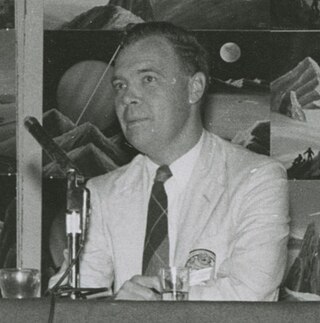
Harry Clement Stubbs, better known by the pen name Hal Clement, was an American science fiction writer and a leader of the hard science fiction subgenre. He also painted astronomically oriented artworks under the name George Richard.
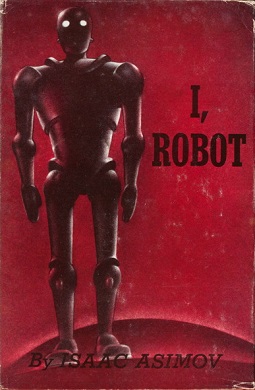
I, Robot is a fixup collection made up of science fiction short stories by American writer Isaac Asimov. The stories originally appeared in the American magazines Super Science Stories and Astounding Science Fiction between 1940 and 1950 and were then collected into a 1950 publication Gnome Press in 1950, in an initial edition of 5,000 copies.

Isaac Asimov was an American writer and professor of biochemistry at Boston University. During his lifetime, Asimov was considered one of the "Big Three" science fiction writers, along with Robert A. Heinlein and Arthur C. Clarke. A prolific writer, he wrote or edited more than 500 books. He also wrote an estimated 90,000 letters and postcards. Best known for his hard science fiction, Asimov also wrote mysteries and fantasy, as well as popular science and other non-fiction.

Murray Leinster was a pen name of William Fitzgerald Jenkins, an American writer of genre fiction, particularly of science fiction. He wrote and published more than 1,500 short stories and articles, 14 movie scripts, and hundreds of radio scripts and television plays.
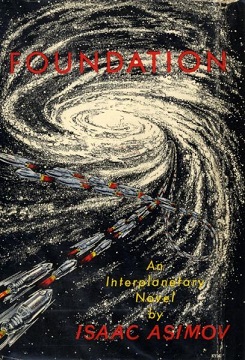
Foundation is a science fiction novel by American writer Isaac Asimov. It is the first book in the Foundation Trilogy. Foundation is a cycle of five interrelated short stories, first published as a single book by Gnome Press in 1951. Collectively they tell the early story of the Foundation, an institute founded by psychohistorian Hari Seldon to preserve the best of galactic civilization after the collapse of the Galactic Empire.
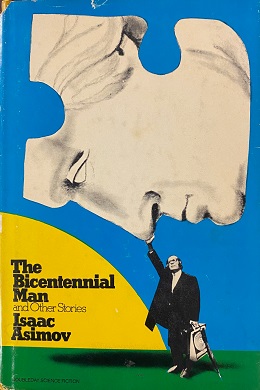
The Bicentennial Man and Other Stories is a science fiction anthology written and edited by Isaac Asimov. Following the usual form for Asimov collections, it consists of eleven short stories and a poem surrounded by commentary describing how each came to be written.

Earth Is Room Enough is a collection of fifteen short science fiction and fantasy stories and two pieces of comic verse by American writer Isaac Asimov, published in 1957. In his autobiography In Joy Still Felt, Asimov wrote, "I was still thinking of the remarks of reviewers such as George O. Smith... concerning my penchant for wandering over the Galaxy. I therefore picked stories that took place on Earth and called the book Earth Is Room Enough." The collection includes one story from the Robot series and four stories that feature or mention the fictional computer Multivac.
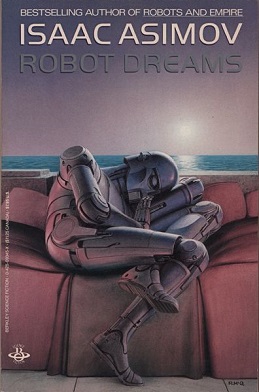
Robot Dreams (1986) is a collection of science fiction short stories by American writer Isaac Asimov, illustrated by Ralph McQuarrie. The title story is about Susan Calvin's discovery of a robot with rather disturbing dreams. It was written specifically for this volume and inspired by the McQuarrie cover illustration. All of the other stories had previously appeared in various other Asimov collections. Four of the stories are robot stories, while five are Multivac stories.

The Rest of the Robots is a collection of eight short stories and two full-length novels by American writer Isaac Asimov, published in 1964. The stories, centred on positronic robots, are all part of the Robot series, most of which take place in the Foundation universe. Another collection of short stories about robots, I, Robot, was re-published in the previous year, which is why Asimov chose to title the collection as The Rest of the Robots. None of the short stories in this collection were in I, Robot, however all of them were later included in The Complete Robot, and both novels about Elijah Baley were also published separately.
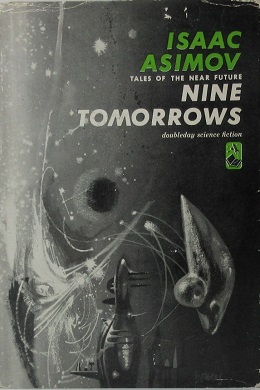
Nine Tomorrows is a collection of nine short stories and two pieces of comic verse by American writer Isaac Asimov. The pieces were all originally published in magazines between 1956 and 1958, with the exception of the closing poem, "Rejection Slips", which was original to the collection. The book was first published in the United States in 1959 and in the UK in 1963. It includes two of Asimov's favorite stories, "The Last Question" and "The Ugly Little Boy".

The Best of Isaac Asimov is a collection of twelve science fiction short stories by American writer Isaac Asimov, published by Sphere in 1973. It begins with a short introduction giving various details on the stories, such as how they came to be written, or what significance merits their inclusion in a "best of" collection, as well as some of Dr. Asimov's thoughts on a best of collection itself. The stories included are two of his early works, two of his late works (post-1960), and eight from the 1950s, which he refers to as his "golden decade" in the introduction. Except for the last story in the book, "Mirror Image", none of the stories are related to his Robot and Foundation series, while a few mention the Multivac computer.

A science fiction magazine is a publication that offers primarily science fiction, either in a hard-copy periodical format or on the Internet. Science fiction magazines traditionally featured speculative fiction in short story, novelette, novella or novel form, a format that continues into the present day. Many also contain editorials, book reviews or articles, and some also include stories in the fantasy and horror genres.
The Golden Age of Science Fiction, often identified in the United States as the years 1938–1946, was a period in which a number of foundational works of science fiction literature appeared. In the history of science fiction, the Golden Age follows the "pulp era" of the 1920s and 1930s, and precedes New Wave science fiction of the 1960s and 1970s. The 1950s are, in this scheme, a transitional period. Robert Silverberg, who came of age then, saw the 1950s as the true Golden Age.

The Winds of Change and Other Stories is a collection of short stories by American writer Isaac Asimov, published in 1983 by Doubleday.
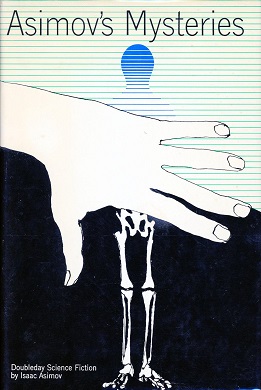
Asimov's Mysteries, published in 1968, is a collection of 14 short stories by American writer Isaac Asimov, almost all of them science fiction mysteries. The stories were all originally published in magazines between 1954 and 1967, except for "Marooned off Vesta", Asimov's first published story, which first appeared in 1939.
"The Machine That Won the War" is a science fiction short story by American writer Isaac Asimov. The story first appeared in the October 1961 issue of The Magazine of Fantasy & Science Fiction, and was reprinted in the collections Nightfall and Other Stories (1969) and Robot Dreams (1986). It was also printed in a contemporary edition of Reader's Digest, illustrated. It is one of a loosely connected series of such stories concerning a fictional supercomputer called Multivac.

Here Comes Civilization is a collection of 27 science fiction stories written by William Tenn, the second of two volumes presenting Tenn's complete body of science fiction writings. It features an introduction by Robert Silverberg and an afterword by George Zebrowski. Tenn provides afterwords to each story, describing how they came to be written.

The Asimov Chronicles: Fifty Years of Isaac Asimov is a collection of forty eight short science fiction and mystery stories and two science essays by American writer Isaac Asimov, published by Dark Harvest in May 1989.

Grand Masters' Choice is an anthology of science fiction short stories edited by Andre Norton and Ingrid Zierhut. It was first published as the convention book for Noreascon Three in a limited edition hardcover by NESFA Press in August 1989. The first paperback edition was published by Tor Books in October 1991. The paperback edition credited Norton alone as editor.
Depending on the counting convention used, and including all titles, charts, and edited collections, there may be currently over 500 books in Isaac Asimov's bibliography—as well as his individual short stories, individual essays, and criticism. For his 100th, 200th, and 300th books, Asimov published Opus 100 (1969), Opus 200 (1979), and Opus 300 (1984), celebrating his writing.

















